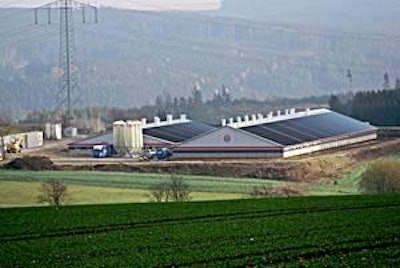
Some European sow housing for the 21st century performed a useful second function in Germany recently, as a hospitality area to receive over 3,000 guests, when one of the country’s newest pig units opened its doors to visitors. The occasion was an “open house” before the new piglet-producing site stocked with animals and started operations.
It has been constructed by the Heberndorf Agrar farm co-operative in the Thüringen area of central Germany. The attraction to visitors of the open house was the chance to view a project that not only meets the latest European Union regulations on houses for sows, but also incorporates some interesting differences in technique.
For example, it uses liquid feeding both in the sow pens and in the piglet nursery. It diverts slurry to a biogas digester and will cut its energy costs further by having solar panels on the pig-house roof. Moreover, the farrowing section has been specially equipped for the fostering of surplus piglets from the larger litters expected now and in the future. Although the extra places involved represent an added cost, the owners calculate that this will be more than covered by the value of the additional piglets produced.
The site at Wurzbach has been given some 4,205 square metres of new housing that is nominally for a total of 851 sows from mating to weaning. Its production basis will be to have 21 groups, each of 34 sows - giving a total of 714 productive females without gilts and reserves. But the dimensions of the sections for insemination and pregnancy would suit a herd size equivalent to 37 sows per group. This relates to the provision of one special fostering pen for every eight farrowing places in the maternity compartment, effectively increasing the group size by almost 9%.
There is an expectation of weaning around 28 pigs per sow/year through the use of Danish genetics. A Danish influence also is obvious in the equipment chosen, which has been supplied by Graakjaer GmbH, German subsidiary of Denmark’s AP Company. For the sows, it has gone into a building that is divided into three main sections. The middle one contains 255 places, mainly in the form of single stalls with three group pens, and acts primarily as the insemination area. It stands between the segments for pregnancy and for farrowing.
Meeting the latest European regulations, the capacity for 384 sows in gestation is provided by a series of group yards equipped with electronic sow feeding stations. A separate station provides ESF training for two pens of gilts. The farrowing section at the opposite end of the building holds five rooms of 34 primary pens plus those for fostering purposes.
Weaned piglets are moved through a short connecting corridor into the nursery, where the eight compartments share the same type of warm-water under floor heating mats employed in the farrowing rooms. Every nursery chamber has 12 pens and there are 30-35 piglets per pen, so there is a total of 395 animals per compartment while the full house holds 3,160 pigs.
The Heberndorf co-op already operates accommodation for over 6000 slaughter pigs, manager Reinhard Telle explained to the open day’s visitors. In the past, however, it had to buy the piglets to fill these finishing pens. Such purchases will no longer be necessary because the addition of the sow complex makes a closed system that is completely self-sufficient.
There can also be a crossover of techniques. The finishing unit is wet-fed with a Weda multi-phase system and this experience can now be applied to the liquid feeding of sows. Adding piglet production also increases supplies of manure for the existing 360kW biogas plant that takes slurry every two weeks through a pressurized pipe from the channels under the concrete slats of the pen floors.





(1).jpg?auto=format%2Ccompress&fit=crop&h=167&q=70&w=250)












